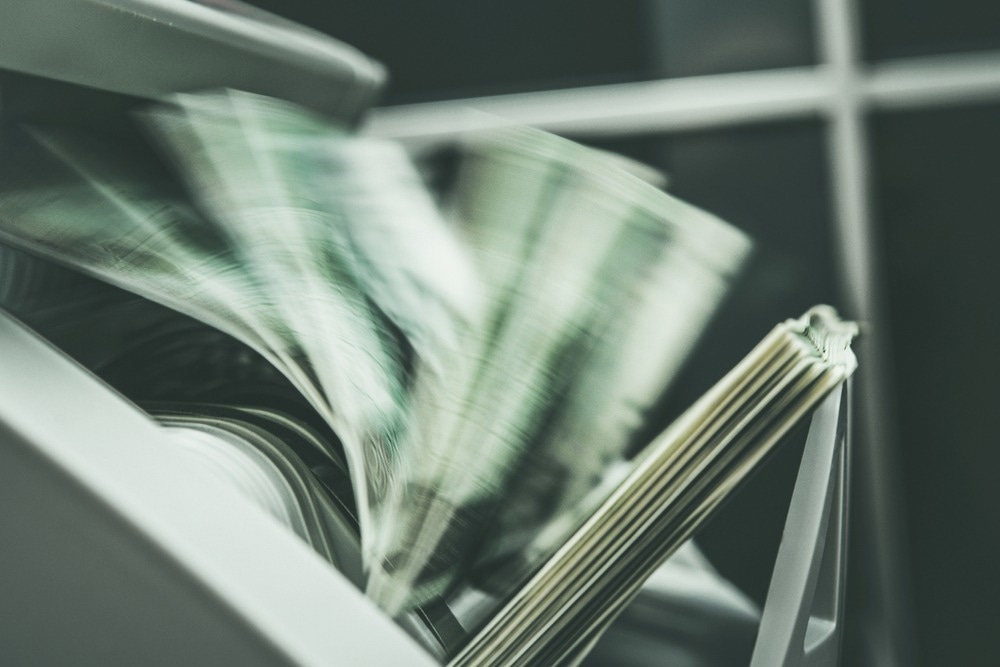A recent study published in Sensors demonstrates an automated system for detecting banknote serial numbers using an optical character recognition framework based on deep learning.

Study: Multi-Currency Integrated Serial Number Recognition Model of Images Acquired by Banknote Counters. Image Credit: Virrage Images/Shutterstock.com
The researchers developed a combined serial number recognition model for the currency of South Korea (KRW), India (INR), the US (USD), and Japan (JPY). Data augmentation and geometric transformations enhanced the banknotes' model accuracy and class imbalance problems.
Automated Machines for Counting Banknotes
Banknotes play a significant role in transactions and ensure a secure storage of wealth. Manually counting banknotes is a common practice. Automated machines enable quick and precise large-scale banknote transactions. These machines include banknote counters, coin counters, automatic vending machines, and automated teller machines for depositing and withdrawing cash.
Most banking transactions are completed using automated machines like banknote classifier machines. Automated machines handle large-scale transactions more quickly and accurately than bank employees.
Automated machines also perform complex operations like banknote recognition, large-scale batch processing, and counterfeit status detection to meet the varied needs of banknote transactions.
Detection of Banknote Serial Number
Counterfeit banknote detection and banknote serial number recognition are the main applications of banknote image analysis. Each banknote that is produced has a banknote serial number engraved on it. This number is an individual alphanumeric identifier that typically has 9 to 11 digits. Identifying and recording the particular serial number of the banknote determines the source and path of circulation of a banknote. The detection of fake currency can be done successfully using this technique.
Serial Number Recognition Process
There are two steps in the banknote serial number recognition process. In the first step, the serial number is extracted as the interest region from the banknote image taken by contact image sensors. Each alphanumeric character is segmented in the extracted serial number region. The Segmentation process uses horizontal-vertical projections.
The Second step involves feature extraction and classification of the character recognition process. Each alphanumeric character’s distinctive characteristics are extracted during the feature extraction stage. Neural networks, support vector machines, and k-nearest neighbors are some of the classifiers used in this process.
Support vector machines are frequently used because they are less prone to overfitting and simpler to use than neural networks. Additionally, they successfully recognize embedded systems installed in terminals in real-time.
Optical Character Recognition (OCR) Algorithms for Banknote Serial Number
Methods for recognizing banknote serial numbers are based on optical character recognition algorithms. Optical character recognition is used in other fields like street number and license plate recognition using Street View images. Banknote serial number recognition demands a higher level of accuracy than other fields adopting optical character recognition because even minor mistakes can lead to significant financial losses. Real-time detection is also crucial for banknote service terminals.
Challenges in Serial Number Recognition
Optical character recognition techniques provide highly accurate results for serial number recognition. The recognition rate is excellent in the ideal case of banknotes with clear background patterns in the serial number region, but in reality, many banknotes lack such patterns. Banknotes with complex patterns have similar backgrounds and serial number styles. These banknotes have similar pixel intensity between the background and characters (which hinders optical character recognition).
These banknotes make feature extraction challenging. Scratches and wrinkles in the serial number region also decrease recognition accuracy. To address the shortcomings of the current algorithms and enhance performance, a deep learning-based approach has been developed owing to the advancement in artificial intelligence techniques.
Development of Deep Learning Based Serial Number Recognition Model
Jang et al. developed a deep learning-based object detection model to locate and categorize serial numbers for recognition.
The serial number regions were taken from the KRW, USD, INR, and JPY banknotes. The researchers offered an integrated multi-currency serial number recognition model based on a deep learning detector structure.
The model output was derived from the feature map of the final block. Experiments were run with various sizes and aspect ratios to find the ideal hyperparameter values.
Research Findings
In this study, a cutting-edge multi-currency integrated serial number recognition method was developed to achieve superior accuracy and inference speed. The best model structure for banknote serial number recognition was determined using deep learning models with four different structural options and a data augmentation method.
The results revealed that the best representation occurred at the last block's layers. The suggested method achieved state-of-the-art performance, with 99.97% accuracy and real-time serial number detection (within 30 ms) for multi-currency serial number recognition. These findings highlighted the significance of modifying the anchor box generation settings throughout the training phase.
The proposed deep learning-based banknote serial number recognition method's ability to identify banknotes accurately while dealing with complex backgrounds was confirmed in this research.
Reference and Further Reading
Jang, W., Lee, C., Jeong, D. S., Lee, K., & Lee, E. C. (2022). Multi-Currency Integrated Serial Number Recognition Model of Images Acquired by Banknote Counters. Sensors, 22(22), Article 22. https://www.mdpi.com/1424-8220/22/22/8612
Disclaimer: The views expressed here are those of the author expressed in their private capacity and do not necessarily represent the views of AZoM.com Limited T/A AZoNetwork the owner and operator of this website. This disclaimer forms part of the Terms and conditions of use of this website.